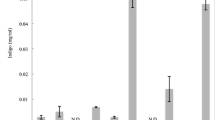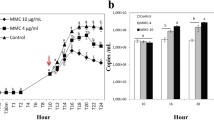Abstract
Endonucleases play a crucial role as reagents in laboratory research and diagnostics. Here, metagenomics was used to functionally screen a fosmid library for endonucleases. A fosmid library was constructed using metagenomic DNA isolated from soil sampled from the unique environment of the Kogelberg Nature Reserve in the Western Cape of South Africa. The principle of acquired immunity against phage infection was used to develop a plate-based screening technique for the isolation of restriction endonucleases from the library. Using next-generation sequencing and bioinformatics tools, sequence data were generated and analysed, revealing 113 novel open reading frames (ORFs) encoding putative endonuclease genes and ORFs of unknown identity and function. One endonuclease designated Endo52 was selected from the putative endonuclease ORFs and was recombinantly produced in Escherichia coli Rosetta™ (DE3) pLysS. Endo52 was purified by immobilised metal affinity chromatography and yielded 0.437 g per litre of cultivation volume. Its enzyme activity was monitored by cleaving lambda DNA and pUC19 plasmid as substrates, and it demonstrated non-specific endonuclease activity. In addition to endonuclease-like genes, the screen identified several unknown genes. These could present new phage resistance mechanisms and are an opportunity for future investigations.




Similar content being viewed by others
References
Daniel R (2005) The metagenomics of soil. Nat Rev Microbiol 3(6):470–478. https://doi.org/10.1038/nrmicro1160
Delmont TO, Robe P, Cecillon S, Clark IM, Constancias F, Simonet P, Vogel TM (2011) Accessing the soil metagenome for studies of microbial diversity. Appl Environ Microbiol 77(4):1315–1324. https://doi.org/10.1128/AEM.01526-10
Luria SE, Human ML (1952) A nonhereditary, host-induced variation of bacterial viruses. J Bacteriol 64(4):557–569
Szalay AA, Mackey CJ, Langridge WHR (1979) Restriction endonucleases and their applications. Enzyme Microbial Technol 1:154–164
Robinson D, Walsh PR, Bonventre JA (2001) Restriction endonucleases. Molecular biology problem solver: a laboratory guide, vol 7. Wiley-Liss, New York, pp 225–266
Lao WD, Chen SY (1986) HsaI: a restriction enzyme from human being. Sci Sin Seri B Chem Biol Agric Med Earth Sci 29(9):947–953
Bickle TA, Kruger DH (1993) Biology of DNA restriction. Am Soc Microbiol 57:434–450
Kennedy J, Marchesi JR, Dobson AD (2008) Marine metagenomics: strategies for the discovery of novel enzymes with biotechnological applications from marine environments. Microb Cell Fact 7(1):27. https://doi.org/10.1186/1475-2859-7-27
Kennedy J, O’leary ND, Kiran GS, Morrissey JP, O’Gara F, Selvin J, Dobson AD (2011) Functional metagenomic strategies for the discovery of novel enzymes and biosurfactants with biotechnological applications from marine ecosystems. J Appl Microbiol 111(4):787–799. https://doi.org/10.1111/j.1365-2672.2011.05106.x
Gu X, Wang S, Wang S, Zhao L-X, Cao M, Feng Z (2015) Identification and characterization of two novel esterases from a metagenomic library. Food Sci Technol Res 21(5):649–657. https://doi.org/10.3136/fstr.21.649
Sharma P, Jindal S, Bala K, Kumari K, Niharika N, Kaur J, Lal R (2014) Functional screening of enzymes and bacteria for the dechlorination of hexachlorocyclohexane by a high-throughput colorimetric assay. Biodegradation 25(2):179–187. https://doi.org/10.1007/s10532-013-9650-5
Rabausch U, Juergensen J, Ilmberger N, Böhnke S, Fischer S, Schubach B, Streit WR (2013) Functional screening of metagenome and genome libraries for detection of novel flavonoid-modifying enzymes. Appl Environ Microbiol 79(15):4551–4563. https://doi.org/10.1128/AEM.01077-13
Ngara TR, Zhang H (2018) Recent advances in function-based metagenomic screening. Genomics Proteomics Bioinform 16(6):405–415. https://doi.org/10.1016/J.GPB.2018.01.002
Gonçalves A, dos Santos A, dos Santos T, Pessoa T, Dias J, Rezende R (2015) High yield of functional metagenomic library from mangroves constructed in fosmid vector. Genet Mol Res 14(144):11841–11847. https://doi.org/10.4238/2015.october.2.17
Uchiyama T, Abe T, Ikemura T, Watanabe K (2005) Substrate-induced gene-expression screening of environmental metagenome libraries for isolation of catabolic genes. Nat Biotechnol 23(1):88–93. https://doi.org/10.1038/nbt1048
Meier MJ, Paterson ES, Lambert IB (2016) Use of substrate-induced gene expression in metagenomic analysis of an aromatic hydrocarbon-contaminated soil. Appl Environ Microbiol 82(3):897–909. https://doi.org/10.1128/AEM.03306-15
Mann MB, Rao RN, Smith HO (1978) Cloning of restriction and modification genes in E. coli: the HbaII system from Haemophilus haemolyticus. Gene 3(2):97–112
Walder RY, Hartley JL, Donelson JE, Walder JA (1981) Cloning and expression of the Pst I restriction-modification system in Escherichia coli. Proc Natl Acad Sci USA 78(3):1503–1507
Segobola J, Adriaenssens E, Tsekoa T, Rashamuse K, Cowan D (2018) Exploring viral diversity in a unique South African soil habitat. Sci Rep 8(1):111. https://doi.org/10.1038/s41598-017-18461-0
Goldblatt P (1997) Floristic diversity in the Cape Flora of South Africa. Biodivers Conserv 6:359–377
Cowling RM, Pressey RL, Rouget M, Lombard AT (2003) A conservation plan for a global biodiversity hotspot—the Cape Floristic Region, South Africa. Biol Conserv 112:191–216. https://doi.org/10.1016/S0006-3207(02)00425-1
Slabbert E, Kongor RY, Esler KJ, Jacobs K (2010) Microbial diversity and community structure in Fynbos soil. Mol Ecol 19(5):1031–1041. https://doi.org/10.1111/j.1365-294X.2009.04517.x
Voelkerding KV, Dames SA, Durtschi JD (2009) Next-generation sequencing: from basic research to diagnostics. Clin Chem 55(4):641–658. https://doi.org/10.1373/clinchem.2008.112789
Scholz M, Lo C-C, Chain PSG, Scholz MB, Miller JR, Earl D, Hyatt D (2014) Improved assemblies using a source-agnostic pipeline for metagenomic assembly by merging (MeGAMerge) of contigs. Sci Rep 4:6480. https://doi.org/10.1038/srep06480
Hall T (2011) BioEdit: an important software for molecular biology Software Review. GERF Bull Biosci 2(1):60–61. https://doi.org/10.1017/S0317167100012865
Altschul SF, Gish W, Miller W, Myers EW, Lipman DJ (1990) Basic local alignment search tool. J Mol Biol 215(3):403–410. https://doi.org/10.1016/S0022-2836(05)80360-2
Keegan KP, Glass EM, Meyer F (2016) MG-RAST, a metagenomics service for analysis of microbial community structure and function. Humana Press, New York, pp 207–233. https://doi.org/10.1007/978-1-4939-3369-3_13
Aziz RK, Bartels D, Best AA, DeJongh M, Disz T, Edwards RA, Zagnitko O (2008) The RAST server: rapid annotations using subsystems technology. BMC Genomics 9(1):75. https://doi.org/10.1186/1471-2164-9-75
Roberts RJ, Vincze T, Posfai J, Macelis D (2010) REBASE–a database for DNA restriction and modification: enzymes, genes and genomes. Nucleic Acids Res 38(Suppl 1):D234–D236. https://doi.org/10.1093/nar/gkp874
Gasteiger E, Hoogland C, Gattiker A, Duvaud S, Wilkins MR, Appel RD, Bairoch A (2005) Protein identification and analysis tools on the ExPASy server. In: Walker JM (ed) The proteomics protocols handbook. Humana Press, Totowa, pp 571–607. https://doi.org/10.1385/1-59259-890-0:571
Sambrook J, Russell DW (2001) Molecular cloning: a laboratory manual. Cold Spring Harbor Laboratory Press, New York
Oliveira PH, Touchon M, Rocha EPC (2014) The interplay of restriction-modification systems with mobile genetic elements and their prokaryotic hosts. Nucleic Acids Res 42(16):10618–10631. https://doi.org/10.1093/nar/gku734
Murray NE (2000) Type I restriction systems: sophisticated molecular machines (a Legacy of Bertani and Weigle). Microbiol Mol Biol Rev 64(2):412–434. https://doi.org/10.1128/MMBR.64.2.412-434.2000
Pool-Stanvliet R (2013) A history of the UNESCO man and the biosphere programme in South Africa. S Afr J Sci 109(9–10):01–06
Vasu K, Nagaraja V (2013) Diverse functions of restriction-modification systems in addition to cellular defense. Microbiol Mol Biol Rev 77(1):53–72. https://doi.org/10.1128/MMBR.00044-12
Williams RJ (2003) Restriction endonucleases: classification, properties, and applications. Mol Biotechnol 23(3):225–243. https://doi.org/10.1385/MB:23:3:225
Neely RK, Roberts RJ (2008) The BsaHI restriction-modification system: cloning, sequencing and analysis of conserved motifs. BMC Mol Biol 9:48. https://doi.org/10.1186/1471-2199-9-48
Stoddard BL, Gwiazda K, Humbert O, Mandt T, Pangallo J, Brault M, Duchateau P (2014) Homing endonucleases from mobile group I introns: discovery to genome engineering. Mob DNA 5(1):7. https://doi.org/10.1186/1759-8753-5-7
Dryden DTF, Murray NE, Rao DN (2001) Nucleoside triphosphate-dependent restriction enzymes. Nucleic Acids Res 29(18):3728–3741. https://doi.org/10.1093/nar/29.18.3728
Orlowski J, Bujnicki JM (2008) Structural and evolutionary classification of Type II restriction enzymes based on theoretical and experimental analyses. Nucleic Acids Res 36(11):3552–3569. https://doi.org/10.1093/nar/gkn175
Gorbalenya AE, Koonin EV (1991) Endonuclease (R) subunits of type-I and type-III restriction-modification enzymes contain a helicase-like domain. FEBS Lett 291(2):277–281. https://doi.org/10.1016/0014-5793(91)81301-N
Ichige A, Kobayashi I (2005) Stability of EcoRI restriction-modification enzymes in vivo differentiates the EcoRI restriction-modification system from other postsegregational cell killing systems. J Bacteriol 187(19):6612–6621. https://doi.org/10.1128/JB.187.19.6612-6621.2005
Loenen WAM, Dryden DTF, Raleigh EA, Wilson GG (2014) Type I restriction enzymes and their relatives. Nucleic Acids Res 42(1):20–44. https://doi.org/10.1093/nar/gkt847
Wilson GG, Murray NE (1991) Restriction and modification systems. Annu Rev Genet 25:585–627. https://doi.org/10.1146/annurev.genet.25.1.585
Roberts RJ, Belfort M, Bestor T, Bhagwat AS, Bickle TA, Bitinaite J, Xu S (2003) A nomenclature for restriction enzymes, DNA methyltransferases, homing endonucleases and their genes. Nucleic Acids Res 31(7):1805–1812
Loenen WAM, Dryden DTF, Raleigh EA, Wilson GG, Murrayy NE (2014) Highlights of the DNA cutters: a short history of the restriction enzymes. Nucleic Acids Res 42(1):3–19. https://doi.org/10.1093/nar/gkt990
Acknowledgements
The work was supported by the Department of Science and Technology, the Technology Innovation Agency and the Council of Scientific and Industrial Research (CSIR). Many thanks to CapeNature for permitting us to access the Kogelberg Biosphere Reserve for soil sampling.
Funding
This study was funded by The Department of Science and Technology (DST), South Africa (ZA), the Technology Innovation Agency (TIA, South Africa (ZA) and the Council of Science and Industrial Research, South Africa (ZA) to Dr. Tsepo L. Tsekoa.
Author information
Authors and Affiliations
Corresponding author
Ethics declarations
Conflict of interest
The authors declare that they have no conflict of interest.
Ethical approval
This article does not contain any studies with human participants or animals performed by any of the authors.
Additional information
Publisher's Note
Springer Nature remains neutral with regard to jurisdictional claims in published maps and institutional affiliations.
Electronic supplementary material
Below is the link to the electronic supplementary material.
Rights and permissions
About this article
Cite this article
Mtimka, S., Pillay, P., Rashamuse, K. et al. Functional screening of a soil metagenome for DNA endonucleases by acquired resistance to bacteriophage infection. Mol Biol Rep 47, 353–361 (2020). https://doi.org/10.1007/s11033-019-05137-3
Received:
Accepted:
Published:
Issue Date:
DOI: https://doi.org/10.1007/s11033-019-05137-3




